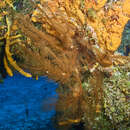en
names in breadcrumbs


"Taxonomic section
Myriopathidae fam. nov.
Diagnosis.— Corallum monopodial or branched; branching irregular or pseudodichotomous. Stem and branches usually pinnulate to varying degrees of regularity. Primary pinnules simple or subpinnulate. Pinnular spines relatively large (maximum height of polypar spines at least two times width along the base), acute, conical, or slightly compressed and blade-like; smooth or finely papillose. Polypar spines generally larger than abpolypar spines. Spines increasing in density on larger branches and stem; becoming acicular and often bifid, trifid, or dendritic. Polyps 0.5-1.0 mm (usually 0.6-0.8 mm) in transverse diameter, with distinct interpolypar space 0.2-0.4 mm in width (in preserved material). Tentacles of fully expanded polyps relatively short and rounded at apex.
Remarks.— This family is established on the basis of the size and morphology of the polyps, tentacles and spines, and on the general pinnulation of the corallum. Myriopathidae is closely related to Antipathidae, but differs from that family in that the polyps are smaller (usually 0.5-1 mm vs. 1 mm or greater), and they have relatively shorter tentacles (one to two times the transverse polyp diameter vs. two or more times the transverse diameter). Furthermore, the tips of the tentacles in Myriopathidae usually appear rounded, whereas in Antipathes sensu stricto the tentacles appear to narrow gradually to a very fine tip. It should be noted these tentacle differences are usually not apparent in preserved material because the tentacles can be very strongly contracted.
The described differences between the polyps of Myriopathidae and Antipathidae are based on a limited number of photographs of living, fully expanded polyps, and the differential diagnosis may need to be refined as more information becomes available. Because of the small size of the polyps of antipatharians, macrophotography in situ is difficult, and informative photographs may only be possible with living specimens maintained in aquaria. However, even in the absence of distinct differences in polyp morphology, there are sufficient differences in sclerenchymal characters to separate the two families. In Myriopathidae the spines are relatively tall and conical (height usually more than twice the width at the base), distinctly unequal, with the polypar spines usually much larger than abpolypar spines, and with the spines increasing in density and becoming more acicular and forked or dendritic on the larger branches and stem. In contrast, in the Antipathidae sensu stricto (excluding species of the genus Aphanipathes), the spines are triangular, laterally compressed, usually not much taller than they are wide at the base, subequal in size around the circumference of the axis (or only slightly larger on the polyp side), and similar in size, shape and density over most of the corallum (i.e., they do not increase in size or density on the larger branches and stem). The occurrence of forked or dendritic spines on the larger branches and stem in the Myriopathidae is the most consistent and reliable character in separating the two families.
Genera of Myriopathidae are distinctly pinnulated with the exception of the genus Antipathella Brook. In species of Antipathella the smallest ramifications of the corallum tend to be non-uniform in size and arrangement and they therefore might more appropriately be referred to as branchlets. Genera of Myriopathidae are differentiated primarily on the basis of the morphology of the corallum, and on the number and arrangement of the branchlets/pinnules.
Key to genera of the family Myriopathidae
1. Pinnules/branchlets simple….. 2
Pinnules subpinnulate….. 3
2. Pinnules in two regular rows….. Plumapathes gen. nov.
- Pinnules/branchlets in one to four irregular rows….. Antipathella Brook
3. Primary pinnules in two rows….. Myriopathes gen. nov.
Primary pinnules in four or more rows….. 4
4. Primary pinnules in four irregular rows; higher order pinnules arranged biserially or uniserially, mostly on upper and lower sides of lower order pinnules ….. Cupressopathes gen. nov.
- Primary pinnules in four to six regular rows and in alternating biserial groups; higher order pinnules usually placed laterally and more extensively developed on abpolypar side of lower order pinnules….. Tanacetipathes Opresko”
(Opresko, 1991)
Myriopathidae is a family of cnidarians belonging to the order Antipatharia.[1]
Genera:[1]
Myriopathidae is a family of cnidarians belonging to the order Antipatharia.
Genera:
Antipathella Brook, 1889 Apanipathes Cupressopathes Opresko, 2001 Myriopathes Opresko, 2001 Plumapathes Opresko, 2001 Tanacetipathes Opresko, 2001